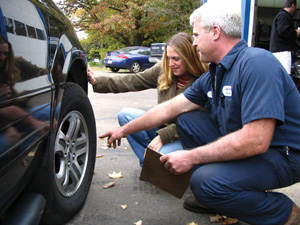 A good tire dealer knows the key to keeping loyal customers is to build relationships with them. And just like maintaining any other relationship, staying connected with customers requires work and, above all else, effective communication.
A good tire dealer knows the key to keeping loyal customers is to build relationships with them. And just like maintaining any other relationship, staying connected with customers requires work and, above all else, effective communication.
But in a business where time is money – and there are always competing demands for your time – it may seem difficult to map out the most efficient way to keep lines of communication open. That’s where a simple plan, along with the cooperation of your entire staff, comes into play. From the moment a customer enters your shop until well after they leave, there are many things to consider when trying to keep them coming back again and again.
Silent Clues
In many cases, it’s not what people say but how they say it that matters most. Body language – nonverbal gestures, postures and facial expressions – communicate messages that you may not even know you’re sending. And researchers have said that 65% to 90% of the meaning transmitted between two people in a face-to-face exchange comes through nonverbal methods alone.
Just think about it: if a customer is trying to get more information about a problem with their vehicle, will they feel important if a counterperson seems distracted, keeps glancing at the clock, and is slouched with his or her arms crossed? Not likely. And you can bet if they don’t feel valued at your shop, they’ll take their money elsewhere.
Keep in mind how your actions and tone of voice are likely to be perceived by others. In order to establish trust with a customer, smile, look them in the eye and speak to them in a way that conveys respect. Even if you’ve got a dozen other things to do at that moment, make each customer feel as if they are your top priority. A firm handshake also goes a long way – remember, you’re not just selling tires, you’re selling yourself, your business and your staff.
The art of using body language to your advantage can also be rolled into your overall “people skills,” a commonly-used term that describes how well you interact with others. And of course, a successful tire dealer knows just how vital those skills are.
Just as your body language conveys a message, so, too, does a customer’s. It’s up to you to interpret that message and use it to your advantage. One sign that may indicate you’ve gained someone’s trust is if they appear relaxed, for example, if they uncross their arms or unlock their ankles.
Be careful not to oversimplify body language, however. Just because a customer’s arms are folded tightly in front of them doesn’t mean they don’t trust you or are uncomfortable with the situation – after all, they could just be cold. Rely primarily on what someone says, and secondly on what is unsaid.
Speaking Up
Obviously, you can’t convey everything you need to tell a customer through body language alone. Before you begin trying to sell a set of tires or a particular service, it’s important to figure out exactly what the customer is looking for – that way you can tailor your sales pitch precisely to fit that person’s needs.
This begins with listening, an often underrated skill. Uncover a customer’s wants and needs by asking questions and listening to the answers, rather than bombarding someone with too many facts and figures. A good place to start is by simply asking what they want out of a tire. Whether the answer is safety, a low price, long tread life or sporty handling, chances are the customer will be impressed you took the time to assess their needs. When recommending tires, note which ones especially meet the requirements that are most important to the customer.
With tires, as well as vehicle service, customers will take note if your staff can provide on-the-spot, detailed knowledge and advice. Carefully explaining procedures that are being performed is important to building trust, but too much technical jargon can quickly overwhelm customers. Without dumbing your explanation down too much, describe everything in simple terms so a customer knows exactly what is happening in the service bay.
Be sure to inform customers what steps will be taken before performing service on their vehicle, as well as any important updates or additional problems found while the work is being done. No one wants to be surprised with a larger than expected repair bill when they come to pick up their car.
Following Through
Another overlooked aspect of keeping customer relationships strong is keeping the lines of communication open even after a person has left your shop. An easy way to impress someone is with a brief phone call asking what they thought of their experience at your store.
If they were in for a new set of tires, ask how the tires are performing or meeting their needs. If the customer came in for vehicle service, inquire about whether they’re pleased with how the problem was fixed. In either case, ask if there was anything you or your staff could have done to improve their experience – and make changes to your business, if needed, based upon this feedback.
Although not quite as personal as a phone call, a follow-up e-mail or survey will also get the job done. To encourage participation, consider offering customers a discount toward future tire or vehicle service purchases with the completion of each survey.
A perfect example of post-visit communication comes from tire industry veteran Barry Steinberg, who owns four Direct Tire & Auto Service locations in and around the Boston metro area. Direct Tire, a Tire Review Top Shop Award Finalist in 2008, reaches out to customers through the dealership’s “Customers First” program.
As part of the program, employees place a note on the rearview mirror of each vehicle after it’s been serviced. The note asks for feedback by referring customers to the company’s Web site. Steinberg says that out of the roughly 190 vehicles serviced daily out of all four locations, at least 10 people e-mail each day with their feedback. “Without that program, I don’t think I’d hear from a lot of people,” he says.
And to make customers feel that personal connection, Steinberg himself e-mails each and every one of them back with a response. He noted that while most customers write with accolades for service or a particular employee, there is the occasional complaint.
“Every time a person has a complaint, I solve the problem, no matter what it is,” Steinberg says.
To get the ball rolling, start by developing a communication plan with your staff that suits the needs of your individual shop, then instruct your employees to follow through. After a little planning and extra effort, you might be surprised at the boost in customer response.













